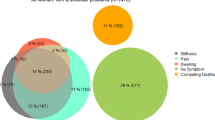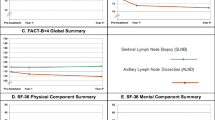Abstract
Arm/shoulder problems and lymphedema are common in patients treated for breast cancer. The Kwan’s arm problem scale (KAPS) is a 13 items self-rating form developed for examination of such problems. Since no such testing has been done, we wanted to examine the psychometric properties of the KAPS. At a median of 47 months (range 32–87 months) post-surgery, 256 stage II breast cancer survivors filled in the KAPS. Findings from physical examination of arm/shoulder function, assessment of lymphedema, and established measures of quality of life (QOL), mental distress and fatigue were used to study convergent and discriminant validity. Factor structure and internal consistency were tested in split-half samples. The total KAPS as well as its two subscales showed high internal consistency (α ≥ 0.92). A two factor solution explained 70% of the variance in the total KAPS score. Convergent validity was shown as the total KAPS score explained 32.5% of the variance in abduction of the ipsilateral shoulder. Discriminant validity was shown as the total KAPS score explained only 6.7% of the variance in abduction of the contralateral shoulder. Concurrent validity was confirmed since the total KAPS explained 54.8% of the variance in arm symptom subscale of breast cancer-specific QOL. Area under the curve was 0.80 for problems of using the arm at a cut-off of the total KAPS score of 21.5. The results show that the KAPS has good psychometric properties supported by high reliability and considerable convergent and discriminant validity.

Similar content being viewed by others
References
Johansen J, Overgaard J, Blichert Toft M, Overgaard M (2000) Treatment morbidity associated with the management of the axilla in breast-conserving therapy. Acta Oncol 39:349–354. doi:10.1080/028418600750013122
Haid A, Köberle-Wührer R, Knauer M, Burtscher J, Fritzsche H, Peschina W et al (2002) Morbidity of breast cancer patients following complete axillary dissection or sentinel node biopsy only: a comparative evaluation. Breast Cancer Res Treat 73:31–36. doi:10.1023/A:1015234318582
Sugden EM, Rezvani M, Harrison JM, Hughes LK (1998) Shoulder movement after the treatment of early stage breast cancer. Clin Oncol 10:173–181. doi:10.1016/S0936-6555(98)80063-0
Clark B, Sitzia J, Harlow W (2005) Incidence and risk of arm oedema following treatment for breast cancer. A three year follow-up study. QJM 98:343–348. doi:10.1093/qjmed/hci053
Nesvold IL, Dahl AA, Løkkevik E, Mengshoel AM, Fosså SD (2008) Arm and shoulder morbidity in breast cancer patients after breast-conserving therapy versus mastectomy. Acta Oncol 47:835–842. doi:10.1080/02841860801961257
Powell SN, Taghian AG, Kachnic LA, Coen JJ, Assaad SI (2003) Risk of lymphedema after regional nodal irradiation with breast conservation therapy. Int J Radiat Oncol Biol Phys 55:1209–1215. doi:10.1016/S0360-3016(02)04273-6
Bentzen SM, Overgaard AM, Thames HD (1989) Fractionation sensitivity of a functional endpoint: impaired shoulder movement after post-mastectomy radiotherapy. Int J Radiat Oncol Biol Phys 17:531–537
Rietman JS, Dijkstra PU, Hoekstra HJ, Eisma WH, Szabo BG, Groothoff JW et al (2002) Late morbidity after treatment of breast cancer in relation to daily activities and quality of life: a systematic review. Eur J Surg Ca 29:229–238
Lee TS, Kilbreath SL, Refshauge KM, Herbert RD, Beith JM (2008) Prognosis of the upper limb following surgery and radiation for breast cancer. Breast Cancer Res Treat 110:19–37. doi:10.1007/s10549-007-9710-9
Sprangers AG, Groenvold M, Arraras JI, Franklin J, te Velde A, Muller M et al (1996) The European Organization for research and treatment of cancer breast cancer-specific quality of life questionnaire module: first results from a three country field study. J Clin Oncol 10:2756–2768
Kwan W, Jackson J, Weir LM, Dingee C, McGregor G, Olivotto IA (2002) Chronic arm morbidity after curative breast cancer treatment: prevalence and impact on quality of life. J Clin Oncol 20:4242–4248. doi:10.1200/JCO.2002.09.018
Ware JE, Snow KK, Kosinski M et al (2000) SF-36® health survey: manual and interpretation guide. Quality Metric Inc., Lincoln
Loge JH, Kaasa S (1998) Short form 36 (SF-36) health survey: normative data from the General Norwegian population. Scand J Soc Med 26:250–258
Ware JE Jr, Gandek B, Kosinski M, Aaronson NK, Apolone G, Brazier J et al (1998) The equivalence of SF-36 summary health scores estimated using standard and country-specific algorithms in 10 countries: results from the IQOLA Project International Quality of Life Assessment. J Clin Epidemiol 51:1167–1170. doi:10.1016/S0895-4356(98)00108-5
Loge JH, Kaasa S, Jensen Hjermstad M, Kvien TK (1998) Translation and performance of the Norwegian SF-36 health survey in patients with rheumatoid arthritis. I. Data quality, scaling assumptions, reliability, and construct validity. J Clin Epidemiol 51:1069–1076. doi:10.1016/S0895-4356(98)00098-5
Chalder T, Berelowitz G, Pawlikowska T, Watts L, Wessely S, Wright D et al (1993) Development of a fatigue scale. J Psychosom Res 37:147–153. doi:10.1016/0022-3999(93)90081-P
Gajdosik RL, Bohannon RW (1987) Clinical measurement of range of movement: review of goniometry emhasizing reliability and validity. Phys Ther 67:1867–1872
Boström C, Harms-Ringdahl K, Nordemar R (1991) Clinical reliability of shoulder function assessment in patients with rheumatoid arthritis. Scand J Rheumatol 20:36–48
Karges JR, Mark BE, Stikeleather SJ, Worrell TW (2003) Concurrent validity of upper-extremity volume estimates: comparison of calculated volume derived from girth measurements and water displacement volume. Phys Ther 83:134–145
Lauridsen MC, Christiansen P, Hessov IB (2005) The effect of physiotherapy on shoulder function in patients surgically treated for breast cancer: a randomised study. Acta Oncol 44:449–457
Acknowledgments
Center for shared Decision Making and Nursing Research, Rikshospitalet University Hospital has funded the first author during the writing up of this paper.
Author information
Authors and Affiliations
Corresponding author
Rights and permissions
About this article
Cite this article
Nesvold, IL., Fosså, S.D., Naume, B. et al. Kwan’s arm problem scale: psychometric examination in a sample of stage II breast cancer survivors. Breast Cancer Res Treat 117, 281–288 (2009). https://doi.org/10.1007/s10549-008-0288-7
Received:
Accepted:
Published:
Issue Date:
DOI: https://doi.org/10.1007/s10549-008-0288-7




